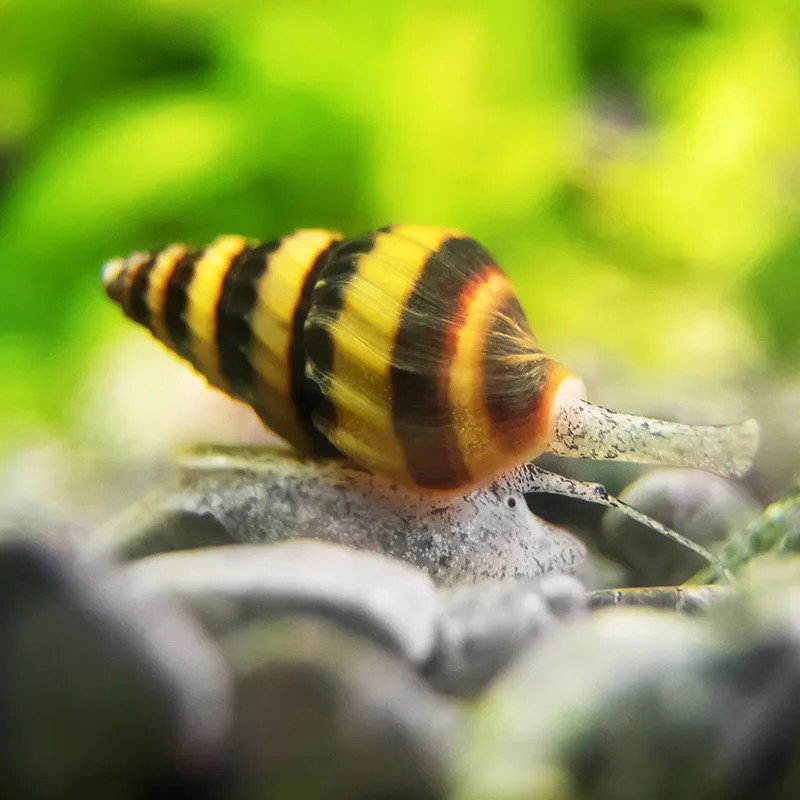Stocks Available
SNAIL-HORNED ALL
SKU:123833
Clithon sp.
0.25 INCH

Stock Available
Introduction Species: Clea helena Common Names: Assassin Snail, Snail-Eating Snail Natural Habitat: Native to Southeast Asia, Assassin Snails are found in freshwater habitats such as rivers, streams, and ponds with sandy or muddy substrates. Physical Characteristics Appearance: The Assassin Snail features a distinctive, conical shell with alternating bands of dark brown and yellow, giving it a striking appearance. Its foot is light-colored, often with speckled patterns, and it uses a siphon for breathing and detecting prey. Size: Grows up to 1 inch (2.5 cm) in length. Lifespan: Typically lives 2-3 years with proper care. Habitat Requirements Tank Size: A minimum of 5 gallons is sufficient for a small group, but larger tanks are preferable if housing with other tank mates. Water Conditions: Temperature: 72-78°F (22-26°C) pH: 7.0-8.0 (neutral to slightly alkaline) Hardness: Moderately hard to hard water (8-15 dGH). Substrate: Sandy or fine gravel substrate is ideal, as it allows the snails to burrow and hunt naturally. Aquascaping: Include hiding spots with driftwood, rocks, and plants. Open spaces on the substrate are essential for foraging. Diet Primary Diet: Carnivorous; Assassin Snails primarily feed on other snails, including pest species like bladder snails and ramshorn snails. Supplemental Feeding: If prey is scarce, they will accept protein-rich foods such as sinking pellets, frozen bloodworms, or fish flakes. Avoid overfeeding to maintain water quality. Feeding Frequency: Feed as needed; they naturally control snail populations in the tank. Behavior and Compatibility Temperament: Generally peaceful but predatory toward other snails. They are not aggressive toward fish or other tank inhabitants. Suitable Tank Mates: Compatible with most community fish species, such as tetras, guppies, and rasboras. They can coexist with shrimp, although they may prey on shrimp fry. Incompatibilities: Avoid housing with slow-moving or delicate snail species, as they may become targets. Care Level Difficulty: Easy; Assassin Snails are hardy and adaptable, making them suitable for beginner aquarists. Health Monitoring: Regularly check water quality and ensure the substrate is clean to prevent stress or health issues. Breeding Breeding in Captivity: Breeding is relatively slow compared to other snails. Spawning Behavior: Females lay single eggs in gelatinous capsules on hard surfaces. Eggs hatch after a few weeks, but juvenile snails grow slowly. Economic Considerations Market Demand: Highly valued for their ability to control pest snail populations, making them a practical addition to many aquariums. Pricing: Affordable and widely available, with prices varying by size and location. Sustainability and Conservation Wild Population: Not considered endangered. Aquaculture Efforts: Frequently bred in captivity for the aquarium trade. Conclusion The Assassin Snail is both a functional and visually appealing addition to freshwater aquariums. Its ability to control pest snails naturally makes it a popular choice for aquarists, while its striking shell adds an aesthetic element to the tank. With minimal care requirements and a peaceful nature, the Assassin Snail is an excellent choice for hobbyists seeking both form and function in their aquatic ecosystems.
Data sheet
9 other products in the same category:
Customers who bought this product also bought: